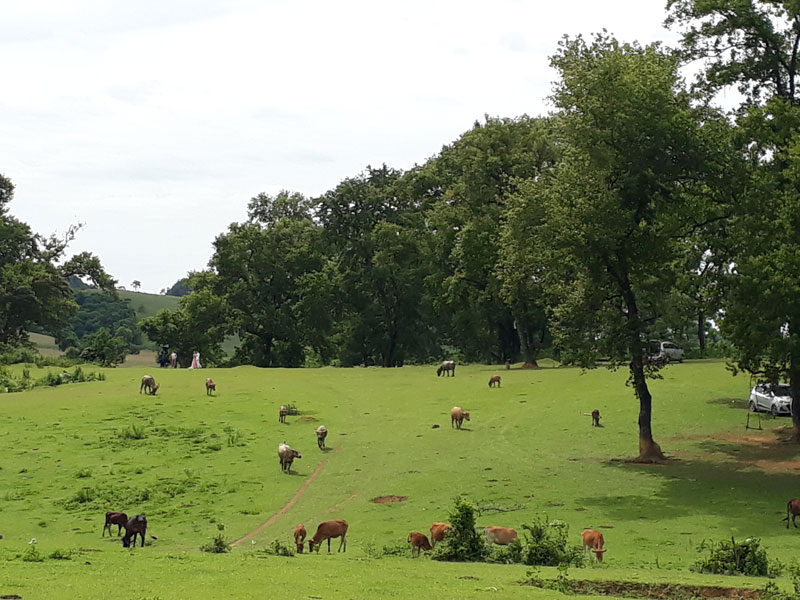
(HBO) - Lac Son - Muong Vang is one of four large Muong ethnic areas in the province. The Muong ethnic people living there account for over 90% of the population. Since the ancient time, Muong Vang has been famous for the typical cultural values featured in Mo Muong rhythm, traditional festivals, beliefs of the people. Besides, Lac Son district is also naturally gifted with mountains and beautiful lakes; rich and various cave system; cool climate. All of these are attractive to tourists who want to explore Lac Son land.
Bai Nha (Ngoc Son commune) is a fairly flat
hill, the bottom of which is fields of paddy, maize, sugarcane yards, the lake
is surrounded by majestic mountains, the primary forest has created so
beautiful natural landscape. This is the ideal place to organize paragliding
activities.
With flat terrain, beautiful scenery,
stretching about 1 hectare, Bai Bui field (Ngoc Lau commune) becomes a stopover
for sightseeing, organizing entertainment activities such as camping, fire -
camping for tourists.
Thung Hill (Quy Hoa commune) is located at an
average height of 1,073m above sea level. Thung Hill has the rolling mountain;
natural scenery is so majestic and romantic.
A tourist site, which is very attractive for
visitors to explore, is Mu Waterfall (Mu village, Tu Do commune). Mu was formed
by an underground stream from majestic mountains at the altitude of above
1,000m above sea level in the Natural Reservation Zone of Ngoc Son - Ngo Luong.
In the Waterfall, there is Mu Cave with the marvels of stalactites. With the
pristine original scenery, majestic mountains and forest, it is one of the
great potential for Lac Son district to explore and develop their tourism.

Bai Bui field, Ngoc Lau commune (Lac Son) is
an ideal stopover for tourists.
Besides the natural tourism potential, Lac
Son district has a revolutionary historical system. According to statistics,
the district has 23 archaeological relics, cultural and historical relics. In
addition, the district preserves many caves of archaeological treasures of
ancient Muong ethnic people, such as: the stone roof of Vanh village is a
national archaeological monument. Khu Dung Cave is one of the beautiful natural
caves of Hoa Binh province. Lac Son also preserves the traditional festivals of
Muong ethnic people, such as Chieng Muong Festival, the festival of field
coming – Du Voi.
In the first 6 months of 2018, the district
has welcomed more than 20,000 visitors, including over 1,000 of international
visitors. The total revenue from tourism has reached over 4 billion VND.
A diverse chain of eco-tourism and resort destinations concentrated in Hoa Binh city and the districts of Tan Lac, Da Bac, and Luong Son… Along with the launch of several key high-quality resort tourism projects, these developments have reshaped the landscape and enhanced the appeal of Hoa Binh as a travel destination.
Boasting diverse terrain, a mild climate, and rich natural resources, Cao Phong district is increasingly asserting its place on Vietnam’s tourism map, attracting both domestic and foreign visitors. The district is renowned for its stunning landscapes, majestic mountains, a crystal-clear hydropower lake, and the unique cultural identity of local ethnic groups.
With its pristine landscapes, unique cultural heritage of Muong ethnic minority, and an expanding range of visitor experiences, Tan Lac district of Hoa Binh has fast become a captivating destination for both domestic and international tourists.
Until now, Sung village in Cao Son commune, Da Bac district remains the only Dao ethnic community in Hoa Binh province to develop a community-based tourism model. Beyond its untouched natural landscapes, cultural identity serves as the cornerstone attraction for visitors.
Alongside the diverse cultural identities of the Kinh, Muong, Tay, Thai, Dao, and Mong ethnic people, Hoa Binh province is also renowned as the "capital" of the northwestern Vietnamese cuisine, offering unique and distinctive dishes. At festivals, during Lunar New Year (Tet), or on significant family or community occasions, special dishes are prepared, leaving a lasting impression on visitors.
A Phong Linh (Yellow Tabebuia) flower garden in Thang village, Thach Yen commune, Cao Phong district is currently in full bloom, drawing a large number of visitors.



